Crown shutter
The Crown are Japanese leaf shutters made by Molta Shōkai, then Chiyoda Kōgaku Seikō (the predecessors of Minolta), in the 1930s and early 1940s. They exist in many models and in three different sizes.
Contents
Crown in #0 size
The Crown first appeared as an everset shutter in #0 size, successor of the Lidex. Four versions were made, differing by the range of speeds and by the presence or absence of a self-timer. On all three, the release lever is at the top left (as seen from the front). The early shutter plate is all black, with the name CROWN engraved at the bottom, the words Patents(J.N.)–Pending then Patents–Nippon engraved at the top, and an MTS logo on the right. The late shutter plate has three metal stripes on each side, the words PATENTS–NIPPON in capital letters at the top and no MTS logo; the name CROWN is now inscribed on a larger aperture scale screwed to the bottom.
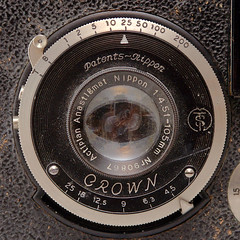 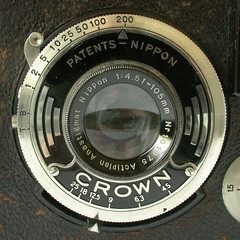
|
| Crown A on the Auto Minolta. Left: old shutter plate. Picture by S. Montagna. (Image rights) Right: new shutter plate. Picture by A. Apra. (Image rights) |
The Crown A,[1] mounted on the Minolta and Auto Minolta, gives T, B, 1, 2, 5, 10, 25, 50, 100, 200 speeds and has no self-timer. Under the release lever, there is a thread for a cable release. A red button is visible further to the bottom; this is a shutter lock, blocking the travel of the release lever when pushed, and disengaged when pulled.[2]
 
|
| Crown A on the Auto Minolta, locked and unlocked. Pictures by A. Apra. (Image rights) |
The Crown B[3] has a slightly reduced speed range, omitting the 1s and 1/2s settings, and the Crown S[3] is similar with an added self-timer. They were mounted on the Happy and on the Minolta Six; the latter always has the newer shutter plate.
 
|
| Crown B on the Happy. Left: old shutter plate. Right: new shutter plate. Pictures by eBayer hbpartner. (Image rights) |
The Crown C[3] is a simplified version giving T, B, 25, 50, 100, 150 speeds, only mounted on the Minolta Six and only known with the newer shutter plate.
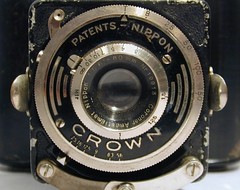  
|
| Crown shutter on the Minolta Six. From left to right: Crown C, Crown B and Crown S. Pictures by eBayer hbpartner. (Image rights) |
Crown in #00 size
The Crown shutter was released in #00 size for the Semi Minolta.
The Crown E
The Crown E[3] was mounted on the Semi Minolta I. It is everset, with the release lever at the top left (as seen from the front), and has a small disc acting as an exposure counter. This disc advances each time the release is tripped and it can be manually reset. It is graduated from 1 to 8 with an intermediate stop between two consecutive numbers so that each number is used twice, as it appears in the red windows. The disc makes two full turns during the 16 exposures and each numbered position is shared by two numbers: 5/1, 6/2, 7/3 and 8/4. The patent for this device was filed on April 16, 1934 and published on October 13 of the same year.[4]
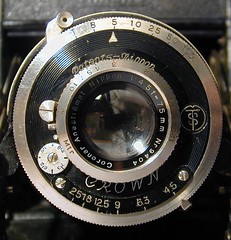 
|
| Crown E on the Semi Minolta I. Left: 1/100 top speed, early shutter plate. Right: 1/200 top speed, late shutter plate. Pictures by eBayer hbpartner. (Image rights) |
The Crown E exists in two versions: the early one gives T, B, 5, 10, 25, 50, 100 speeds, and the late one adding 1/200 top speed. The shutter plate evolved the same as on the #0 size models: all the examples with 1/100 top speed and most examples with 1/200 top speed have a black shutter plate, engraved Patents–Nippon at the top and CROWN at the bottom, and having an MTS logo on the right. The late examples with 1/200 top speed have a newer shutter plate with three metal stripes on each side, the words PATENT–NIPPON at the top and CROWN at the bottom in block letters, and no MTS logo.
The Crown B
The Crown B in #00 size was mounted on the Semi Minolta II. The release lever has moved to the bottom left, to fit the body release mechanism, and the exposure counter disc has been removed; the range of speeds (T, B, 5–200) and the design of the shutter plate are the same as on the late Crown E. The Crown B in #00 size only exists with the newer shutter plate, and the plating of the speed rim switched from nickel to chromium at some time. Some late examples are not everset any more, and have a cocking lever added to the top left. Advertisements for the Semi Minolta II reportedly mention a "Crown A" version, giving T, B, 1–200 speeds.
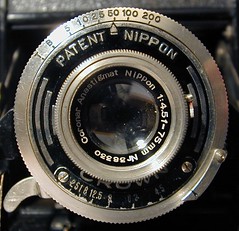 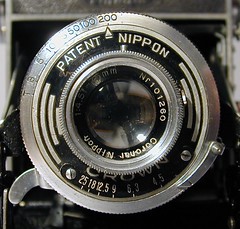 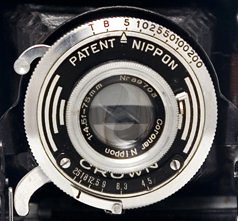
|
| Crown B on the Semi Minolta II. Left: everset, nickel plated. Middle: everset, chrome plated. Pictures by eBayer hbpartner. (Image rights) Right: with cocking lever. Picture by Jamie Bushley from www.virtualcameramuseum.com. (Image rights) |
The Crown II
The Crown II is a newer model developed in #00 size for the Minoltaflex and Minoltaflex Automat TLR models. The earliest examples have T, B, 1, 2, 5, 10, 25, 50, 100, 300 speeds, but the regular version has no T setting. The shutter unit is turned 90 degrees on the TLR cameras, and the speed index is pointing to the left. The shutter plate has three metal stripes above and below the lens; the name CROWNⅡ–TIYOKO is inscribed on a small plate screwed to the left, and the aperture scale is on another plate attached to the right. The release lever is linked to a body release on both TLR models. There is an external cocking lever at the bottom on the original Minoltaflex, also acting as a secondary shutter release, whereas the cocking mechanism is coupled to the film advance on the Minoltaflex Automat. One example has been observd on a Semi Minolta II, with a standard cocking lever.
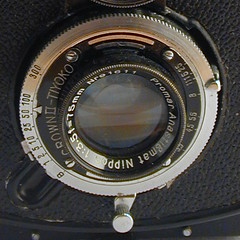 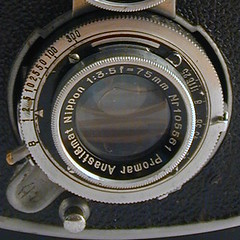
|
| Crown II (B, 1–300). Left: on the original Minoltaflex. Right: on the Minoltaflex Automat. Pictures by eBayer hbpartner. (Image rights) |
Crown-Rapid, in #0 and #1 size
The Crown-Rapid is a completely different model, inspired by the German Compur-Rapid. Its range of speeds is T, B, 1, 2, 5, 10, 25, 50, 100, 200, 400, and it has a self-timer. Two sizes exist: #0 size on the Auto Semi Minolta and #1 size on the Auto Press Minolta. The smaller model has a black shutter plate with three metal stripes on both sides of the lens, and the name CROWNⅡ–TIYOKO at the top; the larger one has a silver shutter plate with Patents–Nippon at the top. Both normally have the name CROWN–RAPID inscribed at the bottom of the speed rim.
One isolated example of the #0-size model has been observed on an Auto Semi Minolta with a reduced range of speeds, going to 1/250 only, and no CROWN–RAPID engraving on the tim. This might correspond to a very early version of the shutter, based on the Compur instead of the Compur-Rapid.
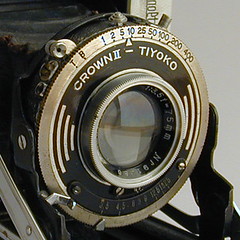 
|
| Left: Crown-Rapid in #0 size on an Auto Semi Minolta. Picture by eBayer hbpartner. (Image rights) Right: Crown-Rapid in #1 size on an Auto Press Minolta. Picture by S. Montagna. (Image rights) |
Notes
- ↑ The name is notably confirmed by an advertisement in Asahi Camera August 1937 reproduced in Kokusan kamera no rekishi, p.97.
- ↑ The short user manual for the Minolta and Auto Minolta found in original leaflets describes the operation of the shutter lock in the reverse direction, presumably because of a mistake in the documents: 手前に軽く引出せば安全装置がかかり、押せば安全装置が外れます.
- ↑ 3.0 3.1 3.2 3.3 The name is notably confirmed by an advertisement in Asahi Camera January 1938, reproduced in Tanimura, p.15 of Camera Collectors' News no.118.
- ↑ Patent reproduced in Tanimura, pp.5–7 of Camera Collectors' News no.131. An extract is also reproduced on p.19 of Kurashikku Kamera Senka no.12.
Bibliography
- Asahi Camera (アサヒカメラ) editorial staff. Shōwa 10–40nen kōkoku ni miru kokusan kamera no rekishi (昭和10–40年広告にみる国産カメラの歴史, Japanese camera history as seen in advertisements, 1935–1965). Tokyo: Asahi Shinbunsha, 1994. ISBN 4-02-330312-7.
- "Kokusan shashinki no genjōchōsa" (国産写真機ノ現状調査, Inquiry into Japanese cameras), listing Japanese camera production as of April 1943. Reproduced in Supuringu kamera de ikou: Zen 69 kishu no shōkai to tsukaikata (スプリングカメラでいこう: 全69機種の紹介と使い方, Let's try spring cameras: Presentation and use of 69 machines). Tokyo: Shashinkogyo Syuppan-sha, 2004. ISBN 4-87956-072-3. Pp.180–7. Shutter items 18-V-15, 18-Q-6, 24-R-1 and 30-R-1.
- Tanimura Yoshihiko (谷村吉彦). "Semi Minolta I-gata gaibun." (セミミノルタⅠ型外聞, "Things heard about the Semi Minolta I") In Camera Collectors' News no.131 (May 1988). Nishinomiya: Camera Collectors News-sha.
- Tanimura Yoshihiko (谷村吉彦). "Semi Minoruta I-gata to II-gata (sono 2)." (セミミノルタⅠ型とⅡ型[その2], Semi Minolta I and II [part 2]) In Camera Collectors' News no.118 (April 1987). Nishinomiya: Camera Collectors News-sha. P.15: reproduction of an advertisement for the Minolta range published in Asahi Camera January 1938.
- Tanimura Yoshihiko (谷村吉彦). "Supuringu kamera <semi minoruta>" (スプリングカメラ<セミミノルタ>, "Semi Minolta" self-erecting camera). Kamera Rebyū: Kurashikku Kamera Senka (カメラレビュー クラシックカメラ専科) / Camera Review: All about Historical Cameras no.12, October 1988. No ISBN number. Minoruta kamera no subete (ミノルタカメラのすべて, special issue on Minolta). Pp.19–24.